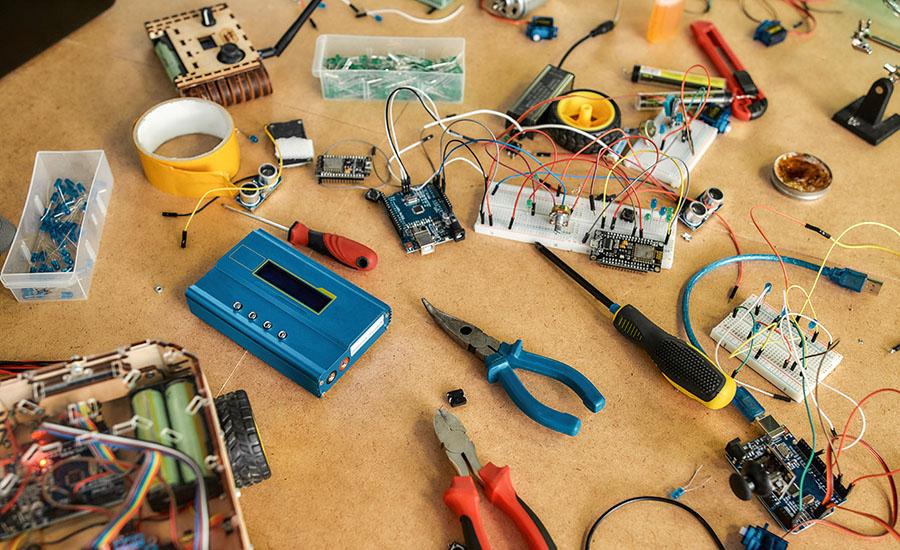Grades:
2nd Grade, 5th Grade, 6th Grade, 8th Grade
This can be taught at different grade levels, diving deeper when possible. Just delete what you don’t need. Students will be creating their own crystal by following the scientific method, collecting
Grades:
8th Grade
Using rock salt, ice, juice, and thermometers, students will use their inquiry framework to investigate how slushies are made and see if they are able to replicate the results of a traditional slushy
Grades:
7th Grade
Students in this lesson will be recording weather data for the city that each student has chosen for 2-3 weeks. Students will be able to record and analyze weather patterns for a selected city
Grades:
6th Grade, 7th Grade
Students will learn basic concepts of physics, including velocity, motion, and vector. S tudents will develop and use a model to predict how forces act on objects at a distance. Finally students will
Grades:
4th Grade, 5th Grade, 6th Grade, 7th Grade, 8th Grade
In this hands-on lesson, students learn how to get their drone into the air. It covers hovering, yaw, roll, and pitch. Before the students launch their drones, there is a discussion about preparing
Grades:
9th Grade, 10th Grade, 11th Grade, 12th Grade
This lesson uses a Modeling Instruction approach to developing the graphical and mathematical relationships for Circular Motion for students in Grades 9-12. Students design an experiment, collect data
Grades:
5th Grade
After watching a video of the space station, students will design and build a model space station containing certain requirements. Students will use scale in order to create a blue print and then
Grades:
3rd Grade
Summary: This lesson is geared towards 3rd graders but can be modified for upper and lower grades. Throughout the next 4 lessons they will describe the role of pollinators and explain their effects
Featured
Parachutes - Air Resistance
Grades:
6th Grade, 7th Grade, 8th Grade
This middle school lesson covers the concept of air resistance. Students work in teams of 3 with a list of materials to design, build, and test 3 parachutes that will maximize the air resistance of a
Grades:
5th Grade
This is the first lesson for the 5th grade life science unit involving environmental factors and organisms. The materials needed are two articles, highlighters, and either a laptop or tablet to
Grades:
9th Grade, 10th Grade, 11th Grade, 12th Grade
This lesson is an introduction to a unit on the light and transverse waves. It can be utilized during a unit or at the beginning as an exploration. Students m easure the speed of light in a medium
Featured
Salt Lamps and Plants
Grades:
7th Grade, 8th Grade
Students in this lesson will set up an investigation to see if a salt lamp affects plant growth. They will use what they know about photosynthesis and cellular respiration to make sure the plants have
Grades:
6th Grade
To demonstrate their understanding of how energy is passed throughout an ecosystem and the symbiotic relationships of organisms within an ecosystem, students construct a food web marble run. This
Grades:
6th Grade
Students explore the limiting factors of yeast over 2-3 days. The materials needed are yeast, sugar, water, ice, tea kettle, empty soda or water bottles, balloons, graduated cylinder, string, ruler
Grades:
8th Grade, 9th Grade
Connect real world situations to the graphs of parabolas through flight. Groups will create PVC stomp rockets, collect data of their rocket's flight path and graph this path on paper to compare to
Grades:
5th Grade
This lesson has an emphasis on explaining what is force. It also has an emphasis on explaining how you can see and measure force. For this lesson you need several empty plastic bottles, rubber bands
Featured
Messin' with Mixtures
Grades:
6th Grade, 7th Grade, 8th Grade
In this lesson, students will investigate the properties of a mixture, as if it were a contaminated soil sample near a stream. This activity will show students that heterogeneous mixtures can be
Grades:
4th Grade, 5th Grade
In this hands-on lesson, students design a safety device (car/seatbelt) that can keep an egg (passenger) safe during a collision. The goal is to protect the egg from cracking during a roll down a ramp
Featured
Dash Around the Table
Grades:
2nd Grade
This is about a one hour lesson where students work in small groups of 2-4 to get their robot around their table using estimation of centimeters. Students will write a program in Blockly that gets the
Grades:
8th Grade
In this lesson students will gather data about local tree diameters. They will then estimate the approximate age of trees. Students build connections between a tree’s growth and environmental factors
Grades:
7th Grade
The lesson gives an introduction to ASCII as part of a set of lessons that introduces computer science. Students learn what a computer can understand and create a bracelet in this introduction to
Grades:
9th Grade, 10th Grade, 11th Grade, 12th Grade
Using the Introduction to Hydroponics lab, introduce students to the features of the Hydroponic Systems. Students will explore the different types of grow mediums and grow lights used in the systems
Grades:
6th Grade, 7th Grade, 8th Grade
Students will create their own cookie cutters to fill a custom order in their bakery. They will need access to 3D design software like Tinkercad and access to a 3D printer. It's even more fun when you
Grades:
1st Grade
In this lesson, students will watch seeds grow on a damp sponge by measuring, journaling and observing. They will observe how the roots and shoots grow.
Featured Lesson Plans
Check out these notable lesson plans.

Grades:
6th Grade
This is the 2nd lesson in a series of 3. In this 8-week project, 6th-grade students will collaborate in small groups to create eco-friendly inventions that aim to reduce their carbon footprints and

Grades:
6th Grade
This is the 1st lesson in a series of 3. 6th-grade students will work in groups to create eco-friendly inventions that help the environment and tackle climate change. They will research ideas, make

Featured
Introduction to Edison Robots
Grades:
6th Grade, 7th Grade, 8th Grade
This outstanding lesson guides students through an introduction to Edison Robots. Students will learn the basic features and sensors while exploring barcode programs. The slideshow and a custom


